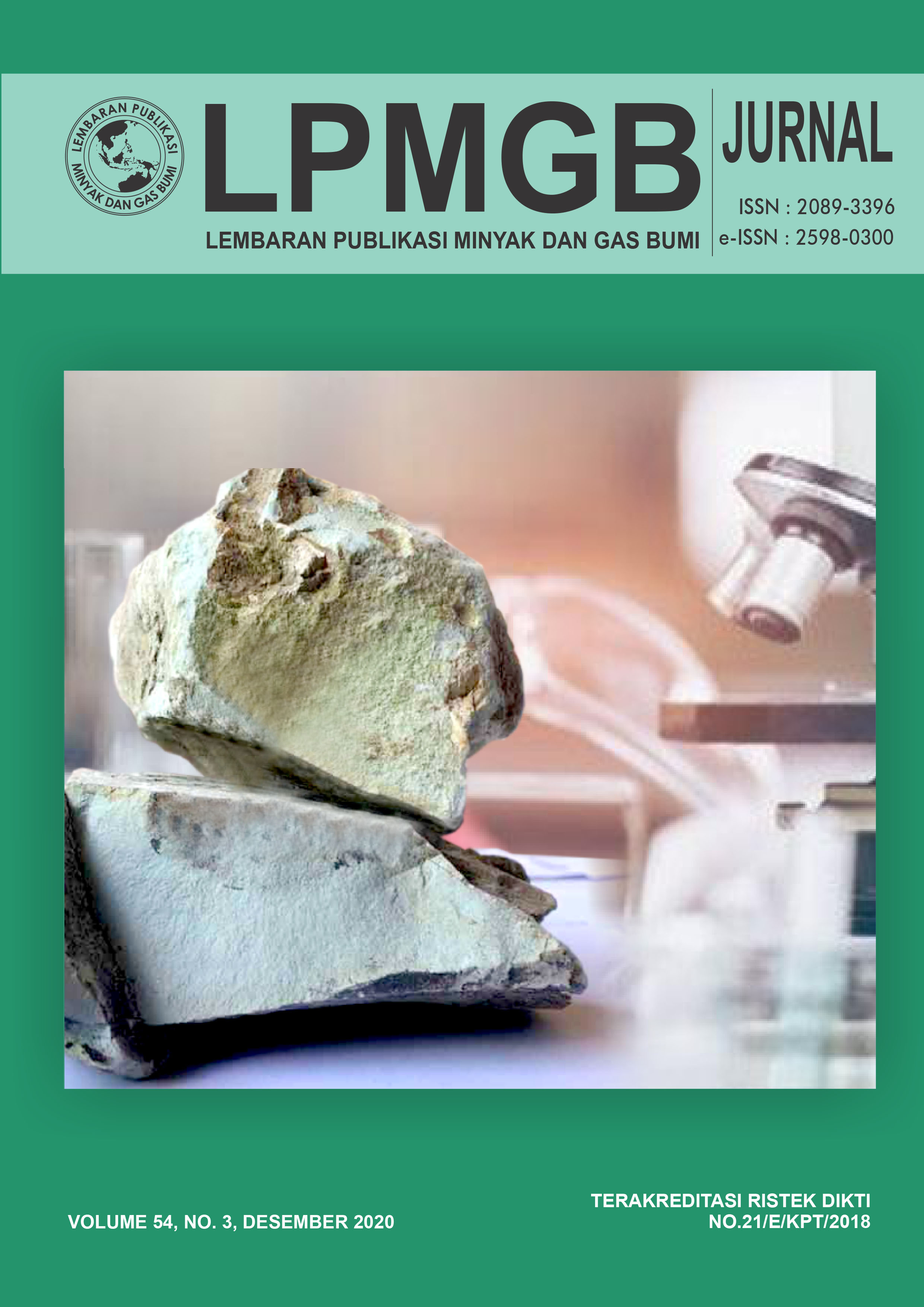Biopolimer dari Bahan Organik sebagai Biopolimer pada Metode EOR
DOI:
https://doi.org/10.29017/LPMGB.54.3.568Kata Kunci:
Biopolimer, Polisakarida, Ekstraksi, ViskositasAbstrak
Rendahnya area sweep efficiency selama waterflooding merupakan salah satu masalah dalam meningkatkan produksi minyak. Sweep efficiency waterflood kurang efektif dikarenakan permeabilitas air yang besar di batuan. Viskositas air bisa meningkat jika menambahkan polimer pada air sehingga bisa mengurangi permeabilitas air dibatuan. Injeksi polimer cukup menjanjikan untuk meningkatkan produksi minyak. Biopolimer merupakan salah satu jenis polimer yang berasal dari mahkluk hidup dengan komponen utama penyusunnya adalah karbohidrat. Bahan yang sering dijadikan biopolimer dan terdapat banyak di alam adalah polisakarida. Untuk mendapatkan polisakarida maka dilakukan ekstraksi pada bahan yang digunakan. Ekstraksi yang digunakan memiliki banyak jenis yang akan mempengaruhi biopolimer yang terbentuk. Pada review ini, berbagai aspek biopolimer dibahas mulai dari sumber biopolimer, jenis ekstraksi, dan serta uji reologi biopolimer.Referensi
Abidin, A. Z., Puspasari, T. & Nugroho, W. A., 2012. Polymers for Enhanced Oil Recovery Technology. Procedia Chemistry, Volume 4, pp. 11-16.
Aditiya, H. B., Mahlia, T.M.I., Chong, W.T., Nur, H., & Sebayang, A.H., 2016. Second generation bioethanol production: A critical review. Renewable and Sustainable Energy Reviews, Volume 66, pp. 631-653.
Afdhol, M. K. Erfando, T., Hidayat, F., Hasibuan, M.Y., & Siregar, C.P., 2020. Application of Pineapple Skin Waste as a Source of Biosolvent for Use as Wax Inhibitor. Journal of Earth Energy Engineering, 9(2), pp. 102-111.
Afdhol, M. K., , 2020. A Laboratory Scale Synthesis of Ethanol from Agricultural Waste as Bio-based Solvent for Waxy-Paraffinic Crude Oil Mitigation. Malacca, Malaysia, IOP Publishing.
Afdhol, M. K., Lubis, H. Z. & Siregar, C. P., 2019. Bioethanol production from tea waste as a basic ingredient in renewable energy sources. Journal of Earth Energy Engineering, 8(1), pp. 21-26.
Agi, A., Junin, R., Abdullah, M. O., Jaafar, M.Z., Arsad, A., Wan Sulaiman, WR., Moh Norddin, M.N.A, Abdurrahman, M., Abbas, A., Gbadamosi, A., & Azli, N.B. , 2020. Application of polymeric nanofluid in enhancing oil recovery at reservoir condition. Journal of Petroleum Science and Engineering, Volume 194, p. 107476.
Agi, A., Junin, R. & Gbadamosi , A., 2018. Mechanism governing nanoparticle flow behaviour in porous media: insight for enhanced oil recovery applications.. International Nano Letters, Volume 8, p. 49–77.
Agi, A., Junin, R., Gbadamosi, A., Abbas, A., Azli, N.B., & Oseh, J., 2019. Influence of nanoprecipitation on crystalline starch nanoparticle formed by ultrasonic assisted weak-acid hydrolysis of cassava starch and the rheology of their solutions. Chemical Engineering and Processing - Process Intensification, Volume 142, p. 107556.
Agi, A., Junin, R., Gbonhinbor, J. & Onyekonwu , M., 2018. Natural polymer flow behaviour in porous media for enhanced oil recovery applications: a review. Journal of Petroleum Exploration and Production Technology, Volume 8, p. 1349–1362.
Al-Saleh, M. A., Yusuf, A.A., Jumaa, M.A., Hammoud, A., & Al-Shammari, T., 2019. Biopolymer solution evaluation methodology: Thermal and mechanical assessment for enhanced oil recovery with high salinity brines. Processes, 7(6), p. 339.
Baumberger, T. & Ronsin, O., 2009. From thermally activated to viscosity controlled fracture of biopolymer hydrogels. The Journal of Chemical Physics, Volume 130, p. 061102.
Bhatt, S. M. & Shilpa, 2014. Lignocellulosic feedstock conversion, inhibitor detoxification and cellulosic hydrolysis–a review. Biofuels, 5(6), p. 633–649.
Binder, G. G., West, R. C. & Kurt, H., 2009. United States Patent Office. Journal of the American Society for Naval Engineers.
Chen, F. & Huang, G., 2019. Extraction, derivatization and antioxidant activity of bitter gourd polysaccharide. International Journal of Biological Macromolecules, Volume 141, pp. 14-20.
Chen, H. & Fu, X., 2016. Industrial technologies for bioethanol production from lignocellulosic biomass. Renewable and Sustainable Energy Reviews, Volume 57, pp. 468-478.
Chen, R., Meng, F., Zhang, S. & Liu, Z., 2009. Effects of ultrahigh pressure extraction conditions on yields and antioxidant activity of ginsenoside from ginseng. Separation and Purification Technology, 66(2), pp. 340-346.
Chen, X., Zhang, H., Du, W., Qian, L., Xu, Y., Huang, Y., Xiong, Q., Li, H., & Yuan, J., 2020. Comparison of different extraction methods for polysaccharides from Crataegus pinnatifida Bunge. International Journal of Biological Macromolecules, Volume 150, pp. 1011-1019.
Chillo, S., Flores, S., Mastromatteo, M., Conte, A., Gerschenson, L., & del Nobile, M.A., 2008. Influence of glycerol and chitosan on tapioca starch-based edible film properties. Journal of Food Engineering, 88(2), pp. 159-168.
Clark, G. L. & Smith, A. F., 1936. X-ray Diffraction Studies of Chitin, Chitosan, and Derivatives. The Journal of Physical Chemistry, 40(7), p. 863–879.
Da Silva, I., Lucas, E. & De Franca, F., 2010. Study of conditions for polyacrylamide use in petroleum reservoirs: physical flow simulation in porous media. Chemistry & Chemical Technology, 4(1), p. 73–80.
Dufresne, A., 2017. Cellulose nanomaterial reinforced polymer nanocomposites. Current Opinion in Colloid & Interface Science, Volume 29, pp. 1-8.
He, L., Yan, X., Liang, J., Li, S., He, H., Xiong, Q, Lai, X., Hou, S., & Huang, S., 2018. Comparison of different extraction methods for polysaccharides from Dendrobium officinale stem. Carbohydrate Polymers, Volume 198, pp. 101-108.
Herring, P. J., 1979. Marine Ecology and natural products. The Journal Pure and Applied Chemistry, Volume 51, pp. 1901-1911.
Huljannah, M., Lestari , F. A. & Erfando, T., 2020. Preliminary Study on The Utilization Of Seaweed and Green Grass Jelly Leaves as Candidate Alternatives for EOR Polymer. Teknik, 41(3), pp. 246-252.
Jang, H. Y., Zhang, K., Chon, B. H. & Choi, H. J., 2015. Enhanced oil recovery performance and viscosity characteristics of polysaccharide xanthan gum solution. Journal of Industrial and Engineering Chemistry, Volume 21, pp. 741-745.
John, M. J. & Anandjiwala, R. D., 2008. Recent developments in chemical modification and characterization of natural fiberâ€reinforced composites. Polymer Composites, 29(2), p. 187–207.
Kaushik, K., Sharma, R. B. & Agarwal, S., 2016. Natural polymers and their applications. International Journal of Pharmaceutical Sciences Review and Research, 37(2), p. 30–36.
Khalid, I., Lestari, F. A., Afdhol, M. K. & Hidayat, F., 2020. Potensi Biopolimer dari Ekstraksi Nanoselulosa Daun Kapas sebagai Agen Peningkatan Viskositas pada Injeksi Polimer. Jurnal Ilmiah Teknik Perminyakan, 9(4), p. 146–153.
Kurita, K., 206. Chitin and chitosan: functional biopolymers from marine crustaceans. Marine Biotechnology, 8(3), pp. 203-226.
Mahdavi, E. & Zebarjad, F., 2018. Screening criteria of enhanced oil recovery methods. In: Fundamentals of Enhanced Oil and Gas Recovery from Conventional and Unconventional Reservoirs. Amsterdam: Elsevier, pp. 41-59.
Obuebite, A. A., Onyekonwu, M. O., Akaranta, O. & Uzoho, C. U., 2018. Effect of Salinity and Divalent Ions on Local Bio Polymers. Lagos, Nigeria, SPE.
Putra, D. & Temizel, C., 2018. The Optimization and Analysis of Hydrocarbon Recovery under Injection of Biopolymer, Synthetic Polymer and Gels in a Heterogeneous Reservoir. Journal of Earth Energy Engineering, 7(1), pp. 19-41.
Pu, W., Shen, C., Wei, B., Yang, Y. & Li, Y., 2018. A comprehensive review of polysaccharide biopolymers for enhanced oil recovery (EOR) from flask to field. Journal of Industrial and Engineering Chemistry, Volume 61, pp. 1-11.
Reddy, N. & Yang, Y., 2005. Biofibers from agricultural byproducts for industrial applications. TRENDS in Biotechnology, 23(1), pp. 22-27.
Rellegadla, S., Prajapat, G. & Agrawal, A., 2017. Polymers for enhanced oil recovery: fundamentals and selection criteria. Applied Microbiology and Biotechnology, Volume 101, p. pages4387–4402.
Rudin, A. & Choi, P., 2013. Biopolymers. In: The Elements of Polymer Science & Engineering (Third Edition) :Academic Press, pp. 521-535.
Shi, L., Ye, Z., Zhang, Z., Zhou, C., Zhu, S., & Guo, Z., 2010. Necessity and feasibility of improving the residual resistance factor of polymer flooding in heavy oil reservoirs. Petroleum Science, Volume 7, p. 251–256.
Stevens, M. P., 1990. Polymer chemistry. 2nd ed. New York: Oxford University Press.
Sveistrup, M, van Mastrigt, F., Norrman, J., Picchioni, F., & Paso, K., 2016. Viability of biopolymers for enhanced oil recovery. Journal of Dispersion Science and Technology, 37(8), p. 1160–1169.
Tabary, R. & Bazin, B., 2007. Advances in chemical flooding. France, IFP-OAPEC.
Telis, V. R. N., 2012. An introduction to biopolymer applications in food engineering. In: Biopolymer Engineering in Food Processing. Boca Raton: CRC Press, pp. 1-16.
Thomas, S., 2008. Enhanced Oil Recovery – An Overview. Oil & Gas Science and Technology, Volume 63, pp. 9-19.
Tobing, E. M. & Eni, H., 2013. Peningkatan Perolehan Reservoir Minyak’R’dengan Injeksi Alkali-Surfaktan-Polimer pada Skala Laboratorium. Lembaran Publikasi Minyak Dan Gas Bumi, 47(2), p. 87–93.
Tsegaye, B., Balomajumder, C. & Roy, P., 2019. Optimization of microwave and NaOH pretreatments of wheat straw for enhancing biofuel yield. Energy Conversion and Management, Volume 186, pp. 82-92.
Wang, T., Li, Y., Xiu, J., Ma, Y., Lin, W., Ma, T., Wang, X., & Wang, L., 2018. A mathematical model for microbial enhanced oil recovery using biopolymer-producing microorganism. Fuel, Volume 216, pp. 589-595.
Wang, X.-Y., 1991. Ch. F-9 Advances in Research, Production and Application of Biopolymers Used for Eor in China.. Developments in Petroleum Science, Volume 31, pp. 467-481.
Wu, H., Shang, H., Guo, Y., Zhang, H., & Wu, H., 2020. Comparison of different extraction methods of polysaccharides from cup plant (Silphium perfoliatum L.). Process Biochemistry, Volume 90, pp. 241-248.
Xia, W., Dong, X., Zhang, Y. & Ma, T., 2018. Biopolymer from marine Athelia and its application on heavy oil recovery in heterogeneous reservoir. Carbohydrate Polymers, Volume 195, pp. 53-62.
Xue, Y., Mou, Z. & Xiao, H., 2017. Nanocellulose as a sustainable biomass material: Structure, properties, present status and future prospects in biomedical applications. Nanoscale, 9(39), p. 14758–14781.
Yang , T. C. & Zall, R. R., 1984. Absorption of metals by natural polymers generated from seafood processing wastes. Industrial & Engineering Chemistry Product Research and Development, 23(1), p. 168–172.
Yubin, J., Miao, Y., Bing, W. & Yao, Z., 2014. The extraction, separation and purification of alkaloids in the natural medicine. Journal of Chemical and Pharmaceutical Research, 6(1), pp. 338-345.
Yuliusman, Y., Afdhol, M. K. & Sanal, A., 2018. Carbon monoxide and methane adsorption of crude oil refinery using activated carbon from palm shells as biosorbent. Bali, Indonesia, IOP Publishing.
Zaharuddin, N. D., Noordin, M. I. & Kadivar, A., 2014. The use of Hibiscus esculentus (Okra) gum in sustaining the release of propranolol hydrochloride in a solid oral dosage form. BioMed Research International, p. 735891.
Zerkalov, G., 2015. Polymer Flooding for Enhanced Oil Recovery. Standford: Standford University.
Zhan, Y., An, X., Wang, S., Sun, M., & Zhou, H., 2020. Basil polysaccharides: A Rewiew on Extraction, Bioactivities and Pharmacological Applications. Bioorganic & Medicinal Chemistry, 28(1), p. 115179.











